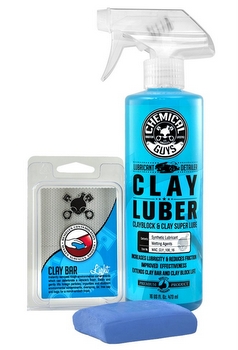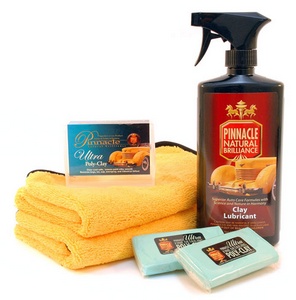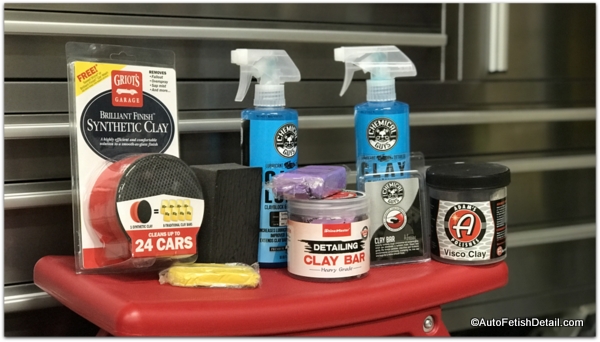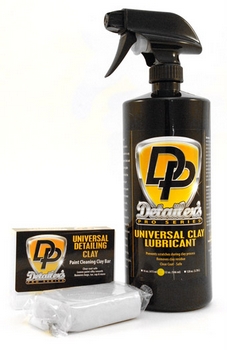Clay Bar for Cars:
Do you really know what you need to know?
Clay bar for cars?!
What does clay and cars have anything to do with each other in the first place, and what do you need to know about detailing clay when it comes to you and your car.
Like most areas of cosmetic car care or the auto detailing process, the subject of clay bars is one filled with plenty of misinformation at best, and bad information at worst.
Clay Bar For Cars
You have questions. I have answers.

Despite the "clay bar or detailing clay being around for literally decades, I am amazed at how many people either are just learning of the clay bar or have wildly incorrect ideas or understanding of the clay bar itself as well as the process of using a clay bar on a car.
With that said, I am going to help you become more informed than most beginner detailers I come across in my travels of being a professional detailer with 30-plus years of real world auto detailing experience.
Let me bullet point the topics I could cover and bury you with so much information your head would spin. So with that said, below I cover the essentials, and here I will simply answer some of the typical questions that arise whenever the subject of clay bar for cars comes up:
- What is clay bar for cars? (a "tool" used to decontaminate your car paint)
- What exactly is the clay bar process? (you rub the clay bar back and forth across your paint while using a clay lubricant to remove the many forms of unwanted contaminants that bond to the surface of your exterior materials eg. paint, glass, chrome, trim, etc.)
- Is claying a car truly necessary? (only if you want silky smooth paint and you don't want to apply wax or polish over "dirty" paint)
- Will using a clay bar scratch car paint? (yes and no. The clay bar will not put deep scratches like the term suggests, but will cause certain levels of abrasions based on how much bonded contaminants are stuck to your car paint)
- If the clay bar will scratch/abrade my car paint, why would I do it? (because it is the only way to remove these unwanted bonded contaminants [there is chemicals that will remove the ferrous contaminants, but these chemicals will not remove other types of bonded contaminants] and once a car owner see's the final results and the fact that they cannot see these abrasions when finished, the trade-off is more than worth it to a car owner)
- How often do I need to clay a car? ( as often as you start to feel a "texture" to your car paint)
- Can you clay a car too much? (No. You will find people that claim you can, but it simply isn't true. You can clay as often as you want. This might be once a month or once year based on where you live, how you maintain your car, and the expectations based on your standards for you and your car)
Clay Bar for Cars:
The overview
Having written on the subject of detailing clay many times and in many places, it still continues to be a subject that quickly becomes complex.
One question being answered always leads to another question with yet another answer. Rinse and repeat.
With that said, I find it helpful for people first hearing of the clay bar to gain a basic understanding initially, knowing that in laying this ground work will always lead to additional questions.

- The clay bar is also known and referred to in many ways: detailing clay, decon bar, decontamination bar, clay mitt, clay sponge, etc. (it isn't necessary to know all the endless names. That will happen naturally once you find yourself on the road of cosmetic car care and detailing in general)
- The clay bar specifically is a synthetic material that is a firm, clay-like material. Typically available in a palm size bar to be used by manually by hand. (think of a bar of soap that is made of synthetic materials/ingredients, rigid in nature, but still malleable/flexible/moldable, etc. Clay bars in are rather tacky/sticky in nature)
- The clay bars ONLY purpose is to decontaminate the exterior surfaces of your car (paint, glass, chrome, hard plastic trim, etc.)
- I will refer to the clay bar as a tool despite very few similarities it has to what most people would label as traditional tools. I do this as it is a tool that serves a very specific purpose with a very specific desired outcome.
- The clay bar process is basic in nature: you rub this clay-type material back and forth across your paint to remove unwanted forms of pollution/contaminants stuck to the surfaces of your car. (this can and should be done to your car paint and glass specifically)
- The clay bar, as part of its synthetic chemistry, is also made with fine abrasive particles that will "shear" away the unwanted surface contaminants.
- The clay bar is meant to be used on a clean car. (a clean car in this context simply means a car that has been freshly washed to remove superficial/traditional forms of dirt)
- Some form of lubricant must be used with a clay bar in order for the clay bar to be rubbed back and forth across any surface of your car. (clay lubricants can be almost any form of liquid that allows for the movement of the clay bar when using on any surface. Yet another subject full of endless opinions and lively debate)
- Despite using a clay lubricant, there is endless debate as to whether the clay bar will scratch your car paint. My simple answer is that it will do some form of "scratching". I personally would not label it as scratching, but abrading. While this may seem like word games to you; there is a big difference. And the additional simple answer to this abrading effect is that for virtually every person I have taught about the clay bar for cars and the process itself, come to the conclusion that the abrading caused is a non-issue as your car paint will be so silky smooth and will look fabulous when you are done that the subtle trade-off is worth it to virtually any car owner. (when you use it the fist time on your pain, it will make disturbing noises as it shears away the different forms of boned contaminants stuck to your car paint)
Clay Bar for Cars:
What Would Darren Do (WWDD)

Before I go into a more exhaustive explanation of all the many questions people have when it comes to clay bar for cars, often people like yourself only require the basics of understanding and then want to rely on my expansive experience and ask me what I would do.
"Darren, I don't need to become an expert on the clay bar, I just want to know what you would do."
Which to that statement; I will tell you what I would do....
- I choose one of the many "versions" of a decontamination tool (clay bar, decon mitt, clay mitt, etc.)
- Choose some form of clay lube to be used in conjunction with the clay bar
- Wash and dry my car
- Proceed to clay bar the entire paint surface and glass of my car
- Follow with my choice in the best car wax
- Stand back and admire the beauty and glow of my car
- I also glide the backside of my hand across the paint to feel just how silky smooth my paint feels
Clay Bar Kits:
Why I think this is the best place to start
I am a big fan of kits and bundles. When you have a specific task of detailing your car, a kit or a bundle is generally more economical and more convenient as you are supplied with everything needed to tackle the job at hand.
For this reason I am going to offer the clay bar kits I recommend as a way for you to get your car decontaminated with professional results.
Mothers 07240 California Gold Clay Bar System
- Comes with (2) clay bars
- Comes with spray detailer to be used as the lubricant
- Comes with a single micro-fiber cloth to mop up lubricant as you do section to section
- Economical, effective, and convenient
Meguiar's G10240 Smooth Surface XL Clay Kit, 240 grams
- Comes with (3) smaller clay bars (many people find this a better option as it allows for smaller clay bars that can be easily used and then discarded as they become progressively dirty over time)
- Comes with spray detailer to be used as the clay lubricant
- Comes with single micro-fiber cloth to mop up lubricant as you do section to section
- Economical, effective, and convenient
Chemical Guys Cly_109 Light Duty Clay Bar and Luber Synthetic Lubricant Kit (16 oz) (2 Items)
- Comes with a single, larger clay bar
- Comes with a dedicated clay lubricant (clay Luber as labeled by Chemical Guys)
- What many in the industry consider more "professional/enthusiast grade clay bar for cars versus the Meguiar's or the Mothers clay bar kits
Nanoskin AUTOSCRUB Fine Grade Wash Mitt [AS-016]
- Another form of a "clay bar"
- Use just as you would a traditional clay bar for cars
- Requires a clay lube just like the traditional clay bars
- Very user friendly in that it conforms precisely to your hand
Clay Bar for Cars:
Darren's Summary

In conclusion I will tell you that I could literally write an entire book on the single subject of clay bars and the many versions, the pros and cons, the specific features and benefits of each individual clay bar or clay bar kit sold.
In the world of cosmetic car care and detailing, there is an overwhelming amount of choices and options. Add to that the countless opinions.
And it is for these reasons that I am offering a more succinct review of clay bar for cars and the essentials of what you need to know. And to answer the question directly as to what I would do (based on being a beginner), I would start with one of the above clay bar kits, clay my car, follow with my choice in the best car wax, and know that I know have a silky smooth paint finish that is free from unwanted contaminants and I can get on with my life and enjoy my car that much more!
I hope this has helped!
Sincerely,

|
|




